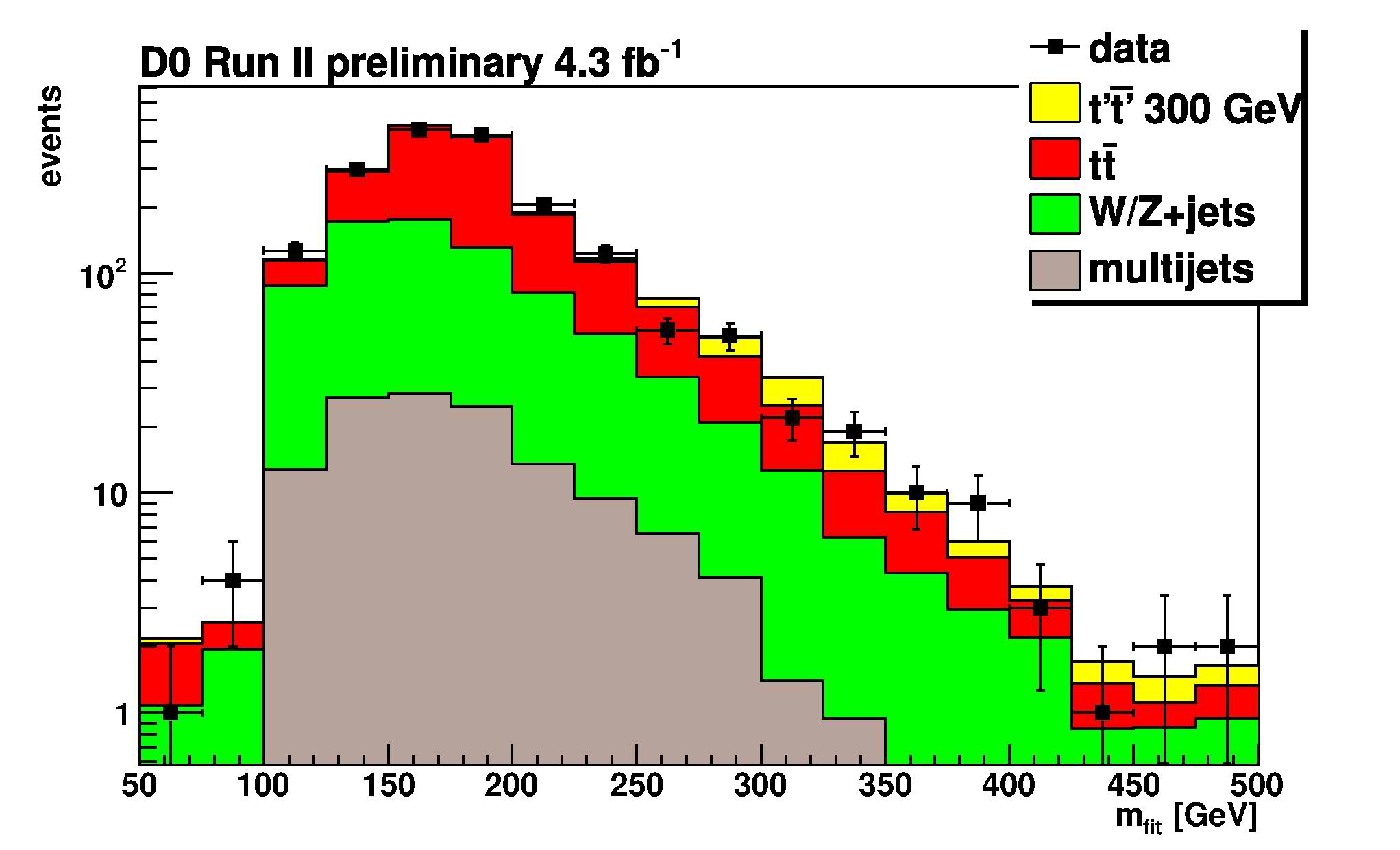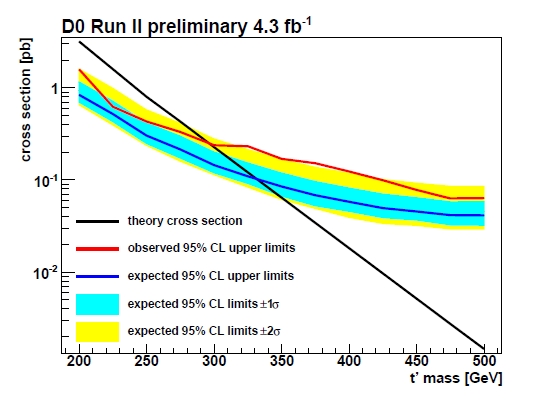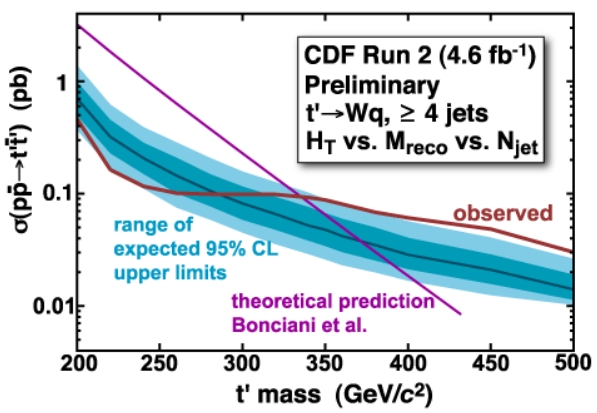In short my question today is, on which signal or phenomenon should we place our chips if we were to bet that the standard model is finally going to break down ?
I have my own answer. But first, before I give it to you, I feel compelled to be extra careful in a couple of ways.
The first way is dictated by personal reasons: I want to state it here very clearly, because I often get fingered as a rumour-monger or overhyper these days. I do NOT believe that the standard model is breaking down any time soon. I have a feeling that we will have to live with it for a while longer. I do not believe in Supersymmetry at arm's reach or anywhere else, nor in other exotics signals that we might see with present-day machines.
(And, since I am going to talk about something like that in particular below: I do not believe we are going to discover a fourth generation of fermions any time soon; I believe the present 2-sigmaish excesses of CDF and DZERO searches for a new t' quark are not due to a signal. If you really want my opinion... they are due to a coherent underestimation of QCD backgrounds, whose root is the use of the same methodologies by the two experiments!)
The second statement consists in my disclaimer, which I will state today as follows:
"The opinions expressed in this article are those of the author, and they do not reflect in any way those of the institutions to which he is affiliated. These include the CDF and CMS collaborations, as well as the Italian Institute of Nuclear Physics."
The above disclaimer is directed in particular at science reporters and other information recyclers... Which should not mistake me for an official source of the experiments in which I work! Of course it is a insufficient shield, but at least nobody can say I have not been clear on the matter.
Okay, now I feel more free to discuss in enthusiastic terms what I think is the single most exciting and promising deviation from standard model predictions that we have in our hands at present: a tentative signals for a fourth generation quark!
Can Fourth-Generation Quarks Really Exist ?
I have kept my eyes open on searches for a new quark since 2008, when a CDF analysis showed some intriguing high-mass events and a vague deviation of data from backgrounds. (The post linked above is rather well written if you need some introduction to the physics!)
After CDF performed the same analysis with doubled statistics, again finding an excess of high-mass events, I thought things were really interesting and I said so here.
In the meantime, there was an enlightening paper which came out in the Cornell Arxiv. Titled "Four Statements About The Fourth Generation", and signed by distinguished theorists, it explained clearly that contrarily to what one might think (or read in the Review of Particle Properties, which makes several assumptions in order to state that a fourth generation is excluded by electroweak measurements), a fourth generation of fermions is not ruled out by experimental measurements, and might actually be useful to explain the amount of CP violation we observe in particle decays. I summarized the paper's highlights in another post which I think is worthwhile reading, if you are interested in the topic.
Well, now DZERO has published the results of a quite similar analysis, and it looks like they too see some excess in the same kinematical distributions that CDF used to search for a fourth-generation quark. Again, this effect can be easily understood in terms of background fluctuations or a mismodeling of the high-mass tail of some of the contributing processes. Yet, the coincidence of the two search results warrants some additional thoughts. So let me first of all show what DZERO has just made public.
The DZERO Search For Fourth-Generation Quarks
DZERO has published, in time for ICHEP 2010, a new search for up-type fourth-generation quarks decaying to W bosons and down-type quarks. In a nutshell, the search considers events of the "lepton plus jets" type: the same kind of events on which all the most precise measurements of top quark physics at the Tevatron are based.
In the lepton-plus-jet topology, top quarks are produced in pairs, decay to a W and a b-quark, and then one W yields two hadronic jets, while the other decays to an electron-neutrino or muon-neutrino pair. This results in one neutrino in the final state, which adds some complexity to the reconstruction of the kinematics (the neutrino is undetected, and only its momentum components transverse to the beam direction can be inferred); however the advantage of having one high-momentum lepton in the event instead of purely hadronic jets is a more than adequate payoff. The events thus must feature a lepton, significant missing energy, and four hadronic jets: backgrounds then are small; the largest is the production of a W boson plus hadronic jets.
When searching for a fourth-generation quark, DZERO does exactly the same thing as in top searches: they assume that the t' quark is produced in pairs, and that it decays 100% of the time into a W boson and a quark (not necessarily a b-quark). The final state is the same as that of top searches, save for the fact that the larger mass of the t' grants a slightly tighter cut on the energy of the leading jet, a device which further reduces backgrounds.
In the end, the data allow the reconstruction of a tentative t' mass, assuming that each event is of the t'-pair-production kind. A kinematic fit searches for the combination of jet assignments to the decay partons which best matches the hypothesized process. One thus obtains a histogram of reconstructed t' mass:

In the figure, you can see with different colours how the predicted amount of events coming from different processes (top pair production in red, W+jets production in green, and multi-jet production in grey) distribute in the reconstructed t' mass. The data is shown by black points with error bars, and it matches very well the predicted shape of backgrounds. An example of what contribution would be given by a 300-GeV t' quark in the histogram is shown in yellow. Tiny, but not entirely undetectable. Mind you: the vertical axis has a logarithmic scale!
What is maybe not so immediate to discern from the figure is the fact that while backgrounds have a wide distribution in the reconstructed t' mass, the signal of a t' quark if present would populate a narrower region: the one around the real mass of the quark. This is entirely the point of having constructed this kinematic variable -discriminating signal and background.
A second discriminating variable is the sum of all transverse energies of the observed final state objects: jets, lepton, and missing energy. This is the so-called "Ht". Ht is large for processes that involve the production of massive states, and so it is a good means to separate t' production from the top and W+jets background. Below you can see how the data compares to backgrounds as a function of Ht; the color coding is the same as above.

DZERO performs a fit in the two-dimensional plane of the t' mass and Ht to extract the possible amount of signal present in the data. This is performed as a function of the unknown value of t' mass: since the distributions of reconstructed mass and Ht of the signal depend on the true t' mass, several fits are performed in series, to extract a limit curve which depends on that parameter; the curve is investigated by points, at 25-GeV intervals in the unknown t' mass.
The result of the fits is displayed in the figure below. The t' mass (this time the "true" one, not the reconstructed tentative mass of the kinematic fits) is on the horizontal axis, and on the vertical axis is the production rate of the fourth-generation quark pair. The black line shows the theoretical prediction for the rate, which falls quickly as the t' mass increases: fewer events are expected in the 4.3 inverse femtobarn dataset of analyzed collisions as the t' mass increases, because the higher the mass, the more energy is required to produce the heavy quark.

The theoretical curve of the signal cross section can be compared with the red curve, which shows the upper limit (at 95% confidence level) extracted from the data. The red curve lies below the black one for low masses: a light t' quark (of masses below 296 GeV) is excluded by the data, because it would have been copiously produced in the Tevatron collisions, and would have stuck out in the two tested distributions. For higher mass values, the limit is above the curve: these mass values are still possible.
Now observe the blue and yellow band: these describe what rates of the searched quark DZERO expected to limit, as a function of t' mass, given the amount of analyzed data they had and the analysis strategy. The blue band shows 1-sigma variations in the expected limit, and the yellow band shows the range of 2-sigma variations. In practice, the bands pictorially explain what "on average" would result from the search, if no signal were present in the data.
Now, the red curve stays on the edge of the 2-sigma band for masses above 300 GeV. What this means is that DZERO has a slight excess of events which distribute like t' production ones in their data. Not awfully exciting, I'll admit. But now compare the curve to the one found by CDF just a few months ago (the analysis which I have discussed in detail here, as already mentioned):

CDF found a strikingly similar result! True, CDF had more sensitivity, so their limit is slightly better; but the behavior of CDF data and DZERO data is indeed quite similar. A fortuitous coincidence between two 2-sigma results ? That is surely a possibility; another one is that the two experiments, which rely on similar simulation tools, both underestimated the high-energy production of top or W+jets production events.
Yet a third possibility remains on the table: that both CDF and DZERO are seeing the first hint of pair production of a fourth-generation quark. The amount of data of the two experiments would be insufficient to see a clear signal yet, so the first hint is just that they both obtain a mass limit well below their expectations.
Now, suspend temporarily your disbelief and consider. If a 400-GeV t' quark exists, who is going to discover it first ? For sure CDF and DZERO with twice as much statistics (which they almost already have in their bags) would be likely to make those 2-sigma excesses become close to 3-sigma ones. Maybe adding other search channels would further increase their reach; but they would probably be unable to conclusively discover the quark.
Instead, on the other side of the Atlantic Ocean... CMS and ATLAS would be very fast in finding conclusive evidence for such a quark! The reason is that producing a 400-GeV t' quark at LHC is much, much easier, given the over 3.5 times higher energy of the LHC collisions. The cross section at the LHC is of several picobarns, which means that well before collecting an inverse femtobarn of collisions, the CERN experiments will find the new quark!
Now, let me say something personal, deep down this long post. I have always said that, despite I have been working more on the CMS experiment at CERN than on the CDF experiment at the Tevatron since 2008, my heart still beats stronger on the Tevatron side... That is still true in a sense: CDF is such a fantastic achievement for science that I will always be proud of having contributed to it for 18 years (and counting). But if you ask me which experiment I would prefer to see discovering a t' quark... I would say CMS!
The reason ? CMS and ATLAS deserve to become the focus of the next decade of high-energy physics research. Too much has been invested in human resources for these experiments to fall short of being a total success. I would love it if the adventure of the LHC experiments into the unknown were to start with a t' discovery, early next year! It would be just great!
... But now please go back and read my original disclaimer once more!

This comment has been removed by a blog administrator.
ReplyDelete